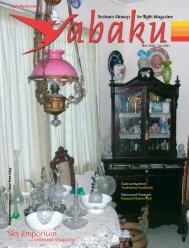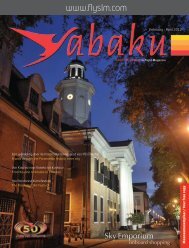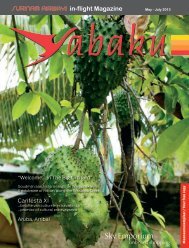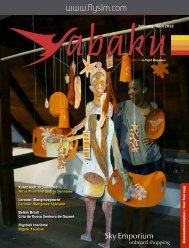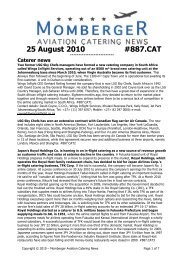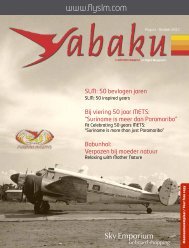onboard shopping - Surinam Airways
onboard shopping - Surinam Airways
onboard shopping - Surinam Airways
- No tags were found...
Create successful ePaper yourself
Turn your PDF publications into a flip-book with our unique Google optimized e-Paper software.
Without kilts or bagpipes?:Scots in <strong>Surinam</strong>eFrench, English, Dutch, Portuguese, Germans,Jews, not necessarily in that order, allhave helped as competing colonists to weavethe ethnic patchwork we know as <strong>Surinam</strong>e.Few would know that the Scots made a contributionas well. Still, the Scots and theirproverbial thrift contributed to the developmentof <strong>Surinam</strong>e. Not dressed in kilt or withbagpipes, the stereotype image of the Scot.At least no proof was ever found for it.During the English intermediate administrationin <strong>Surinam</strong>e (1804 – 1816) a group ofScottish people arrived here. This emigrationtook place within the scope of a stimulationprogram from the English government whichencouraged its citizens, Scottish amongthem, to emigrate to overseas dependencies,including <strong>Surinam</strong>e. As an incentive theywere given plantations and slaves. The emigrationof Scottish to <strong>Surinam</strong>e was furtherencouraged by the so called clearances thatwere in effect since 1760. The clearances impliedthat on land in the Scottish Highlandswhich could be utilized for grazing sheep,people had to move elsewhere. In first instancewith a financial compensation, but inlater years even by force. This was enough ofan incentive for a group that chose to cometo <strong>Surinam</strong>e in the beginning of the 19 th century.They settled in the district of Coronie.The first plantations established by the Scottishdate back to 1808 and produced cottonprimarily. But a flourishing coffee culture wasachieved as well.It can be justifiably stated that the districtsof Coronie and Nickerie were, in the beginningof the 19 th century, developed with capitalfrom England and Scotland.Almost all place names in Coronie are of Englishor Scottish origin.The settlers who established plantations inthat region mostly gave English names totheir plantations, names like Totness, Inverness,Hamilton, Friendship, Burnside forinstance.In Coronie we also find places with a biblicalname, e.g. Salem where the EvangelicalBrother Congregation established a missionarypost from the middle of the 19 th century.At Salem there is still an important churchand a school from the Moravians.In the course of the 18 th and 19 th centuryplantations in other districts were makingprogressively less money. There were tworeasons for this. The first was that in the 18 thcentury more and more plantations were theproperty of owners that did not live in <strong>Surinam</strong>e,but primarily in the ‘Batavian Republic’.The Batavian Republic (1795-1801) wasa republic that included the largest part ofthe actual Netherlands. The republic wasformed after and with military support fromFrance whereby the Batavian Republic wasan ally and in fact a satellite state. But thisassistance was very expensive: yearly the Republichad to pay tens of millions of guildersfor the French troops stationed in Holland(Treaty of The Hague). Later on the coalitionwith France appeared rather one-sided.In their wars against the English and the ensuingpeace negotiations the French were alltoo eager, in exchange for promises by theEnglish, to relinquish Dutch colonies.In the meantime plantation owners hadmade so much money that they had returnedto The Netherlands. They left the plantationwork to directors in salaried employment.The profit made by the plantation went directlyto the plantation owner in Holland.Since the officers received their salary anywaythey missed the urge to work hard.Because of the absenteeism of the owners theplantations deteriorated with lower productionand revenues as a direct consequence.A second reason for the decline of the plantationswas an issue primarily in the 19 th century.It all started when Napoleon Bonaparte,having conquered large parts of Europe andas an opponent of slavery forbade the importof cane sugar from the Caribbean and hadit replaced by the planting of sugar beets inEurope. This sugar was cheaper than thecane sugar from <strong>Surinam</strong>e.The competition from other colonies played arole as well, as a result of which the demandfor <strong>Surinam</strong>ese cane sugar and other productsdecreased.In 1863, at the abolition of slavery, plantationshad predominantly English and Scottishowners.Other than the absent Dutch plantationowners the Scottish put into practice the adagethe master’s eye makes the horse fat. Andbesides they acted cost-consciously. Thatis where the proverbial Scottish thrift cameinto play. Act cost-consciously implied thattheir thinking and their acting were focusedon an optimal usage of time, money and othermeans. They were budget-conscious andsaw to it that no overspending took place.w w w. f l y s l m . c o m51



